About
Our research interests are focused on three main aspects of developmental neurobiology and neurodegeneration: development of new lab on chip devices for neurobiological research, new strategies to avoid α-synuclein and tau transport in neurons and new approaches to enhance axon regeneration after lesion.
Development of new lab on chip devices for neurobiological research
One of our focus is to mimic the developing and neurodegenerating nervous system in lab on chip devices. We believe that combining several different stimuli in the chip resembles a more realistic environment that nerve cells will encounter in the living animal in normal and disease conditions. These experiments using la bon chip models in turn will make future studies on the role of neuronal cells in development and regeneration more accurate and complete. Thus, we developed a new device able to reproduce the formation of the neuromuscular junction (NMJ) in lab on chip devices. In addition, a device designed to analyse axon lesions of cortical neurons was also developed.
We developed a new device able to reproduce the formation of the neuromuscular junction (NMJ) in lab on chip devices.
Current experiments of our group in collaboration with groups of IBEC, CIBER-BBN, and other labs aimed at developing new lab on chip devices to mimics and modulate particular neurobiological processes. For example: i) on chip lab platform to monitor drug delivery modulating neuronal activity (see figure); ii) cortico-spinal chips to develop axon regenerative studies of new drug formulation (in collaboration with Imperial College; London); iii) devices tmigrating neurons (in collaboration with i3A, Zaragoza) and, iv) in silico 3D modeling for neurodegenerative diseases (Alzheimer and Parkinson chip).
Last experiments are focused to reproduce a lab on chip devices to analyse and to reproduce ALS models (in collaboration(Alzheimer and Parkinson chip). Last experiments are focused to reproduce a lab on chip devices to analyse and to reproduce ALS models (in collaboration with Biodonostia Hospital) (Figure 2).
New strategies to avoid α-synuclein and tau transport in neurons
α-Synuclein is a key player in the pathogenesis of synucleinopathies, including Parkinson’s disease, dementia with Lewy bodies, and multiple system atrophy. Transmission of synthetic α-synuclein aggregates has been demonstrated in several cellular and animal models. Several groups have reported that insoluble α-synuclein shows “prion-like” propagation in wild-type mice. However, the basis of the spreading process remains poorly understood although cell to cell transport via exocytosis has been proposed. We described in 2018 that PrPC is a new receptor for α-synuclein involved in their spreading and propagation. Our new objectives aimed to block this interaction to reduce the neuropathological transport of α-synuclein. Similar experiments are also developed in the case of tau, one of the hallmarks of Alzheimer´s disease, since tau also binds to PrPC during its inter-neuronal propagation.
New approaches to enhance axon regeneration after lesion
Following axonal lesions in the adult CNS, damaged axons degenerate, while surviving fibres are unable to regenerate, and have a limited capacity to sprout and to re-establish lost connections. Experimental evidence suggests that providing a permissive extracellular environment containing cellular or biomaterial bridges is not enough to increase axon regrow to obtain functional regeneration, supporting the importance of clarifying the complex transcriptional response below these signalling pathways. As an alternative, activating or recapitulating the developmental program of the lesioned neuron to sprout and regenerate may represent a complementary therapeutic approach and may sometimes directly counteract the inhibitory signalling. Optogenetics is currently the state-of-the-art method for activity-based nervous system research, allowing more specific cellular stimulations by light in a less invasive techniques compared to classical electrical stimulation, but leading to a more tailored physiological response3. In our laboratory, we started to analyse whether optical stimulation of lesioned neurons is able to enhance axonal growth or sprouting. These experiments were performed on lesioned cortical neurons in vitro and in vivo.
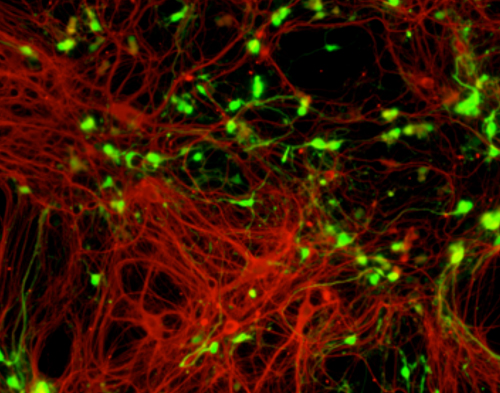

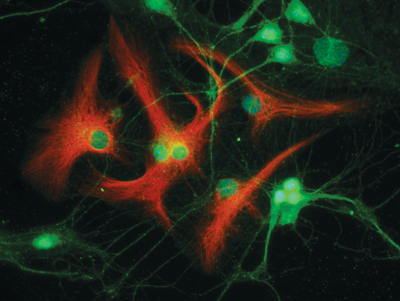
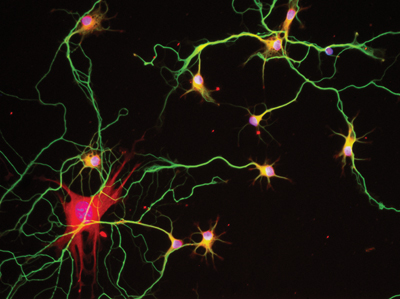
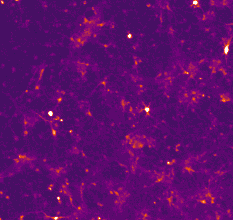
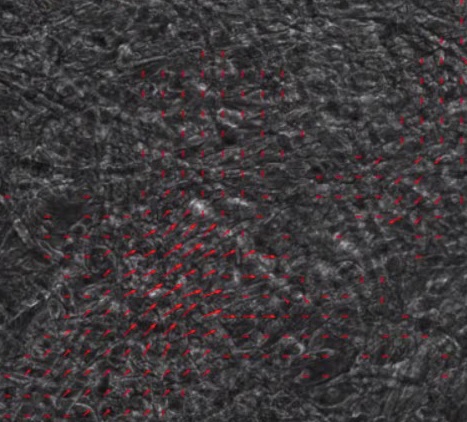
Staff
José Antonio Del Río Fernández
- Jordi Duran Castells, associated researcher
Projects
| NATIONAL PROJECTS | FINANCER | PI |
|---|---|---|
| PRPSEM · Nuevas aproximaciones para entender las funciones de la PrPC y miembros secretables de semaforinas durante el desarrollo del hipocampo y en neurotransmisión (2019-2022) | MICIU (Retos investigación: Proyectos I+D) | José Antonio Del Río |
| STOPTAUPATHOL · Modulation of Tau seeding and pathology in tauopathies by BBBnanocarriers, epitope selective vaccination and ectoPrP Tau receptor bodies (2019-2022) | Obra Social “La Caixa” | José Antonio Del Río |
| HDAC3i-SCI-EAE Inhibición de la HDAC3 como terapia para lesiones medulares y enfermedades autoimmunes demielinizantes (2021-2024) | MICIU (Retos investigación: Proyectos I+D) | Arnau Hervera |
| FINISHED PROJECTS | FINANCER | PI |
|---|---|---|
| DEVREG Nuevas funciones de PlexinD1/Sema3E, PrPC y las proteínas asociadas a la mielina durante el desarrollo de la corteza cerebral de roedores y en neurodegeneración (2013-2016) | MINECO Investigación fundamental no orientada | José Antonio Del Río |
| Red Nacional de Priones (2015-2017) | MINECO, Acciones Dinamización “Redes Excelencia” | José Antonio Del Río |
| NEURODEV Nuevas funciones de PlexinD1/Sema3E, PrPC y las proteínas asociadas a la mielina durante el desarrollo de la corteza cerebral (2013-2016) | MINECO, I+D-Investigación fundamental no orientada | José Antonio Del Río |
| Mecanismos epigenéticos implicados en la etiología y progresión de las demencias neurodegenerativas rápidamente progresivas (2015-2016) | MINECO | José Antonio Del Río/Miguel Calero |
| Monitoring neurocognitive deficits in Alzheimer’s and Parkinson’s diseases using saliva or blood-derived biomarkers and a multiplexed approach | Obra Social La Caixa | José Antonio Del Río |
| Spanish Network of Neurodegerative Diseases of the Ministry of Heath (FIS) (2009-2017) | CIBERNED, Reference: P1-L14 | José Antonio Del Río |
| ANGIODEVSNC Funciones de genes implicados en angiogénesis y remodelación vascular durante el desarrollo cortical y en neurodegeneración (2016-2019) | MINECO, Retos investigación: Proyectos I+D | José Antonio Del Río |
| Role of the cellular prion protein as “cross-talk” protein between a-syn/ LRRK2 and p-Tau in sporadic and familiar Parkinson’s disease (2015-2018) | Fundació La Marató de TV3 | José Antonio Del Río |
| Robots biológicos basados en el control de la union neuromuscular (2016-2019) | MINECO, Programa EXPLORA, Reference: TEC2015-72718-EXP | Josep Samitier |
| Red de Excelencia Nacional de Priones (2016-2018) | MINECO, Reference: AGL2015-71764-REDT | José Antonio Del Río |
Publications
Equipment
- Neural stem cell culture
- Microscopy facility (Olympus BX61 and Olympus IX71 with LCi culture and OKOlab systems)
- Electroporation system (BTX 600)
- Pressure microinjection system
- Protein expression and purification systems
- Technology of neuronal culture facilities (2D and 3D)
- Lentiviral production and characterization
- Protein and DNA electrophoresis
- In situ hybridization oven
- Optogenetic in vitro and in vivo stimulation system
Collaborations
- Dr. Adolfo Lopéz de Munain
Hospital de Donostia, San Sebastian, Spain - Dr. Joaquin Castilla
CiC Biogune, Bilbao, Spain - Prof. Juan María Torres
INIA-CISA CSIC, Valdeolmos, Madrid, Spain - Prof. José María Delgado and Prof. Agnest Gruart,
UPO, Sevilla, Spain - Prof. Jose Manuel García Verdugo
Facultad de Ciencias, Universidad de Valencia, Spain - Prof. Jose Manuel García Aznar
Nanotechnology Institute, Zaragoza, Spain - Prof. Fernando Albericio and Ernest Giralt
Institute for Research in Biomedicine (IRB), Barcelona - Dr. Miriam Royo
Institute for Research in Biomedicine (IRB), Barcelona - Dr. Elisabeth Engel, Prof. Josep Samitier, Prof. Xavier Trepat and Prof. Daniel Navajas
IBEC - Prof. Ángel Raya
Center of Regenerative Medicine in Barcelona (CMRB) - Dr. Antonella Consiglio and Dr. Franc LLorens
Institut d’Investigació Biomèdica de Bellvitge, University of Barcelona, Spain - Prof. Jesús Ávila and Prof. Francisco Wandosell
Consejo Superior de Investigaciones Científicas (CSIC), Universidad Autónoma de Madrid, Spain - Prof. Isidro Ferrer
Institut d’Investigació Biomèdica de Bellvitge, University of Barcelona, Spain - Dr. Alberto LLeó
Hospital Sant Pau, Barcelona, Spain - Prof. Miquel Vila
VHIR, Barcelona, Spain - Prof. Fanny Mann
Developmental Institute of Marseille Luminy, Université de la Méditerranée, Marseille, France - Prof. Yutaka Yoshida
Division of Developmental Biology, Cincinnati Children’s Research Foundation, Cincinnati, Ohio, USA - Prof. Masato Hagesawa
Faculty of Medicine, Tokyo - Prof. José Luis Lanciego
CIMA, Navarra, Spain
News

Tau, a key protein against Alzheimer’s
José Antonio del Río, group leader at IBEC, has received funding from the “CaixaHealath” call from “la Caixa” to continue advancing in the fight against Alzheimer’s.
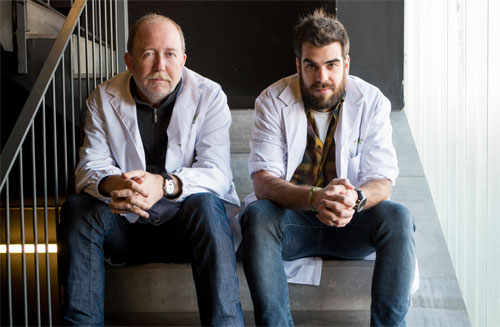
Identified a new repairing mechanism of the peripheral nervous system by applyting bioengineering techniques
The Molecular and cellular neurobiotechnology group with the collaboration of the Nanobioengineering group, both of them at IBEC, have applied a new light-stimulated technique to modulate muscular activity and stimulate cell regeneration of the peripheral nervous system. Thanks to this research they have discovered that muscle activity can activate the neurons and accelerate their regeneration after an injury.
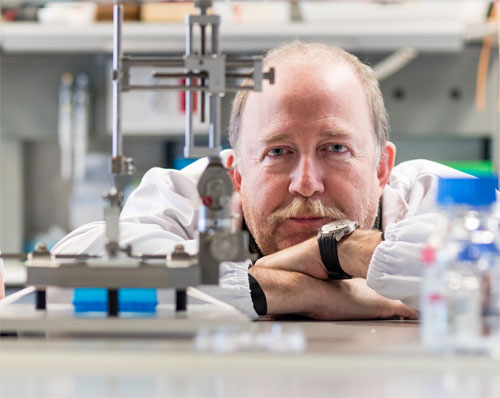
New advances in the improvement of the design of drugs against glial globular tauopathy
José Antonio del Río, principal investigator at the Institute for Bioengineering of Catalonia (IBEC) together with Dr. Isidre Ferrer from Bellvitge Biomedical Research Institute (IDIBELL) led a study where they have unraveled that the pathology shown by patients with Globular Glial Tauopathy is due to the generation of harmful protein deposits for neurons and glial cells. Tauopathies are characterized by the accumulation of phosphorylated tau protein, that associates with phosphate groups.
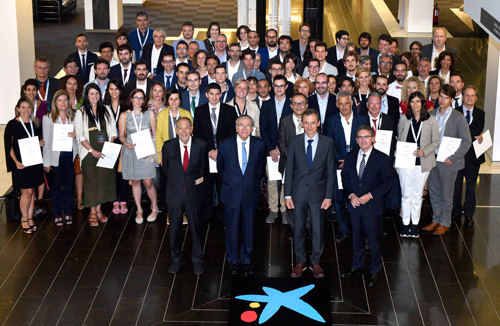
Three researchers from IBEC awarded with grants from “la Caixa” for their pioneering and high social impact research
José Antonio del Río, Pau Gorostiza, and Samuel Sánchez have been awarded in two of the “la Caixa” calls. José Antonio del Río, principal investigator of the Molecular and Cellular Neurobiotechnology Group at IBEC, is one of the winners of the second edition of the call for applications in biomedicine and health. Del Río’s project focuses on analysing the molecular mechanisms involved in the genesis and propagation of tau protein in brain cells. This protein is linked with several neurodegenerative processes and is present in numerous diseases such as Alzheimer’s. Pau Gorostiza, principal investigator of the Nanoprobes and Nanoswitches Group, also received an award at the second edition of the call for applications for research projects in biomedicine and health. In this case, for his project on degenerative eye conditions such as retinitis pigmentosa, which causes blindness due to the progressive degeneration of the cones and rods, which are the light sensitive cells.
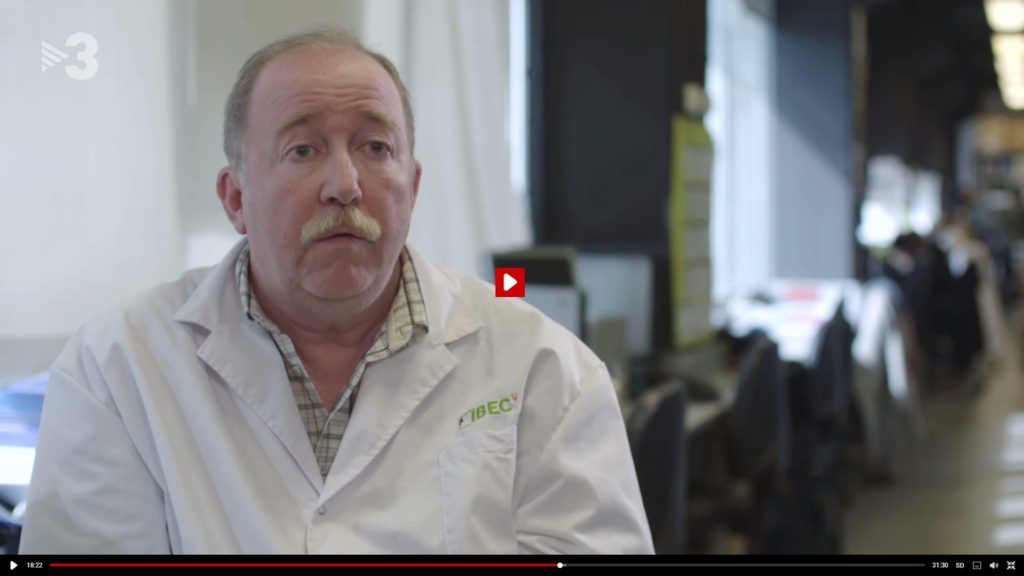
José Antonio del Río interviewed at “La Marató dels investigadors” TV program
Last sunday 14th July, José Antonio del Río was interviewed at “La marató dels investigadors” TV program to celebrate the closure of cicle of “la Marató 2013” which was dedicated to neurodegenerative diseases, in which his research recieved funding.
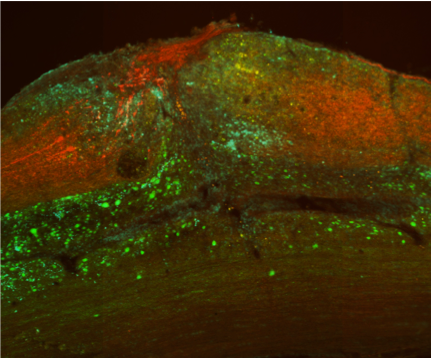
A mechanism has been discovered that could improve spinal cord injuries
A study led by researchers from IBEC and Imperial College London has identified a mechanism that regulates the regenerative failure in lesions of the central nervous system. For the first time, experts have also proven how the genetic or pharmacological inhibition of the new therapeutic target could overcome regeneration failure following spinal cord injury Will I recover from this injury? Answering this question that many patients ask themselves after a fall or any other type of accident or disease is still a major challenge. And the fact is that the molecular mechanisms that discriminate between regeneration success or failure remain a mystery to science. Although lesions of the peripheral nervous system may be partially reversible, lesions of the central nervous system cannot regenerate themselves in the same way. This lack of regenerative capacity is mainly responsible for the functional deficits that appear after a spinal cord injury, for example.

José Antonio del Río presents the results about his research at the 20th Symposium of “La Marató de TV3”
José Antonio del Río, group leader of the Molecular and cellular neurobiotechnology group at IBEC, presented at the 20th Symposium of “La Marató de TV3”, the results of his research on neurodegenerative diseases boosted by the funds of “La Marató” in 2013. During the event, which took place this weed at the “Institut d’Estudis Catalans”, it has been made public the results of the 79 research teams that have carried out the 44 financed projects by the 2013 edition of this program. A set of achievements targeted to design new tools of prevention and diagnostic, as well as new therapeutic approaches to improve the quality and life expectancy of the patients that suffer a neurodegenerative disease. .
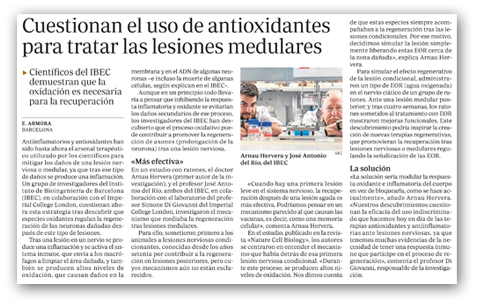
“Cuestionan el uso de antioxidantes para tratar las lesiones medulares”
Yesterday’s press release about Arnau Hervera and José Antonio del Río’s work, together with Imperial College, that was published in Nature Cell Biology and described their discovery that oxidizing species regulate the regeneration of damaged neurons after spinal cord injuries, was covered in ABC and El Progreso today.

A mechanism that regulates neurogenesis in the adult brain
Scientists from IBEC’s Molecular and Cellular Neurobiotechnology group have discovered a protein and its receptor that control the spread of adult stem cells in the hippocampus, the part of the brain responsible for memory. The discovery could shed light on the mechanisms involved in memory, the development of neurodegenerative diseases such as Alzheimers, or in the development of brain tumors caused by the uncontrolled proliferation of various cell types.
Jobs
Laboratory Assistant at the Molecular and Cellular Neurobiotechnology Group
Ref: LA-TR // Deadline: 28/10/2025
Research in Training at the Molecular and Cellular Neurobiotechnology Group
Ref: RT-TR // Deadline: 27/10/2025
Predoctoral researcher at the Molecular and Cellular Neurobiotechnology Group (Project THRIVE)
Ref: FPI_JADR_RG // Deadline: 29/10/2025
Laboratory Technician at the Molecular and Cellular Neurobiotechnology Research Group (LT2-JADR)
Ref: LT2_JADR // Deadline: 13/11/2023
Laboratory Technician at the Molecular and Cellular Neurobiotechnology Research Group (LT-JADR)
Ref: LT_JADR // Deadline: 23/10/2023
Predoctoral researcher at the Molecular and Cellular Neurobiotechnology Group (Phd_JADR)
Ref: Phd_JADR // Deadline: 30/09/2023
Postdoc researcher at the Molecular and Cellular Neurobiotechnology Group (Ref: PD-TR)
Ref.: PD-TR / Deadline: 10/02/2023
PhD Researcher at the Molecular and Cellular Neurobiotechnology Group (Ref: PhD-TR)
Ref.: PhD-TR / Deadline: 30/01/2023
Laboratory Technician at the Molecular and Cellular Neurobiotechnology Research Group (Ref: LT-TR)
Ref: LT-TR // Deadline: December 26
Laboratory Technician at the Molecular and cellular neurobiotechnology Research Group
Application Deadline: 22/07/2022Ref: LT_TR The Molecular and cellular neurobiotechnology group at the Institute for Bioengineering of Catalonia (IBEC) is looking for Laboratory Technician to contribute to the development of novel methods for Neurodegenerative studies using microfluidics and in vitro platforms. The contract will be within the framework of the project “Fabrication of novel microfluidic devices and applications to monitor tau-related neurodegeneration in vitro”.


 ibecbarcelona.eu
ibecbarcelona.eu